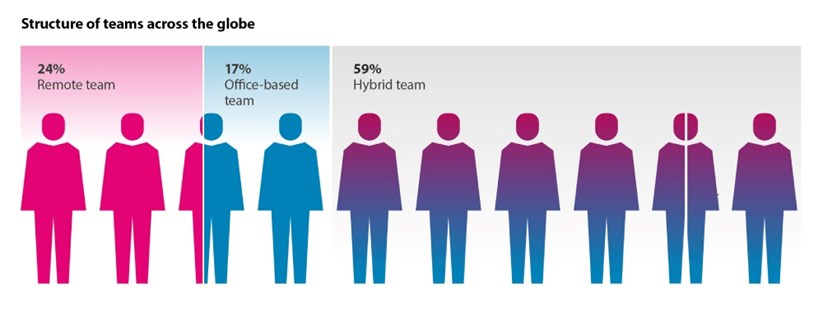A new global study by Insights Learning & Development has uncovered the growth in hybrid working across the world and highlights changing attitudes to how hybrid teams prefer to work - with the office as the least desirable option. Only one-fifth (20%) of hybrid workers globally say they want to be based in the office for most of the time, and the majority would prefer fully remote working.
The international survey of 3,000 office workers across USA, UK, Canada, France, Germany, Netherlands and Denmark found that 92% of teams are more hybrid since the pandemic and 72% want to maintain it.
Overall, work structures consist of 59% hybrid (flexible workplaces), 24% remote and 17% office based. Internationally, the most popular setup amongst hybrid workers is occasionally visiting the office (44%).
UK employees questioned, desired a more flexible approach to their working pattern, with over two-thirds of hybrid workers mainly office-based (67%), and almost half wanting to work remotely more.

The overriding advantage is having more time, as the daily commute has been dramatically reduced, with 66% of hybrid employees across the globe confirming it as a bonus. The people of the Netherlands are benefiting from this the most with a resounding 72% agreeing, and the USA and the UK are close behind. Notably, improved health and well-being are also one of the biggest benefits identified for UK hybrid workers questioned, compared to other countries across the globe.
Building social connections was raised as the most difficult aspect, with 40% of hybrid teams across the globe confirming it’s the most challenging area of the new world of work. Teamed with the barrier of getting to know new team members within hybrid teams identified by respondents.

Within the hybrid teams surveyed, six out of ten employees prefer the structure in which they already work. At country level, the Netherlands (70%) are the happiest with their current work set up, and the most dissatisfied are France (54%). Many companies seem to be aware of their employees’ needs and establish a hybrid model that fits best.
Overall, working fully remote is the most satisfying structure globally; three-quarters of employees who never work in an established office would still choose this way of working. Office-first is the least attractive, as only 10% of dissatisfied employees would prefer to switch to an office-based workplace.
Chief Executive of Insights Learning & Development, Fiona Logan suggests empowering individuals in their approach to their working setup is important in the new world of work:
 “This report is confirming what many suspected, that flexibility in working practices has been internationally welcomed by employees. It is not surprising to see regional preferences shift when it comes to how we work together, and the key for employers is to find a balance that works for our teams and for the business. We all have different preferences and therefore these new routines will work in different ways for different people. At Insights we work with some of the world’s leading organisations supporting them to recognise that putting their people and wellbeing at the heart of the business strategy will reap significant productivity benefits.
“This report is confirming what many suspected, that flexibility in working practices has been internationally welcomed by employees. It is not surprising to see regional preferences shift when it comes to how we work together, and the key for employers is to find a balance that works for our teams and for the business. We all have different preferences and therefore these new routines will work in different ways for different people. At Insights we work with some of the world’s leading organisations supporting them to recognise that putting their people and wellbeing at the heart of the business strategy will reap significant productivity benefits.
“Additionally, as we are now not in the office each day together, we need to create a culture and community that fully supports and enables success. Creating a community between remote and in-person work is imperative and the need for human skills, a core purpose and connection are vital for this. As this research shows, businesses need to look at effective ways that truly empower people in how they work and by providing the solutions they need to feel connected and supported, no matter where they are working.”